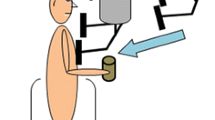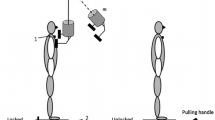Summary
This study investigated the effect of initial stance configuration on automatic postural responses in humans. Subjects were tested in both bipedal and quadrupedal stance postures. The postural responses to horizontal translations of the supporting surface were measured in terms of the forces at the ground, movement of the body segments, and electromyographic (EMG) activity. Postural responses to the same perturbations changed with initial stance posture; these responses were biomechanically appropriate for restoring centre of mass. A change in stance configuration prior to platform movement led to a change in both the spatial and temporal organization of evoked muscle activation. Specifically, for the same direction of platform movement, during bipedal stance muscles on one side of the lower limb were activated in a distal to proximal sequence; during quadrupedal stance, muscles on the opposite side of the lower limb were activated and in a proximal to distal sequence. The most significant finding was an asymmetry in the use of the upper limbs and the lower limbs during postural corrections in quadrupedal stance. Whereas antagonists of the upper limb were either co-activated or co-inhibited, depending on the direction of translation, lower limb antagonists were reciprocally activated and inhibited. Human subjects in a quadrupedal stance posture used the lower limbs as levers, protracting or retracting the hips in order to propel the trunk back to its original position with respect to the hands and feet. Postural responses of the subjects during quadrupedal stance were remarkably similar to those of cats subjected to similar perturbations of the supporting surface. Furthermore, the same predominance of lower limb correction is characteristic of both species, suggesting that the standing cat is a good model for studying postural control in humans.
Similar content being viewed by others
References
Allum JHJ (1975) Responses to load disturbances in human shoulder muscles: the hypothesis that one component is a step test information signal. Exp Brain Res 22:307–326
Baldissera F, Hultborn H, Illert M (1981) Integration in spinal neuronal systems. In: V B Brooks, (eds) Handbook of physiology, Section 1, Vol II. Am Physiol Soc, Bethesda, pp 509–595
Clement G, Rezette D (1985) Motor behavior underlying the control of an upside-down vertical posture. Exp Brain Res 59:478–484
Cordo PJ, Nashner LM (1982) Properties of postural adjustments associated with rapid arm movements. J Neurophysiol 47:287–302
Dunbar DC, Horak FB, Macpherson JM (1984) Neural control of quadrupedal and bipedal posture. Am J Phys Anthropol 63:153
Dunbar DC, Horak FB, Macpherson JM, Rushmer DS (1986) Neural control of quadrupedal and bipedal stance: implications for the evolution of erect posture. Am J Phys Anthropol 69:93–105
Dunbar DC, Horak FB, Macpherson JM, Rushmer DS, Russell CJ (1983) Postural correction in feline and human subjects during both quadrupedal and bipedal stance. Neuroscience Abstr 9:63
Gielen CCAM, Ramaekers L, Van Zuylen EJ (1988) Longlatency stretch reflexes as co-ordinated functional responses in man. J Physiol 407:275–292
Gordon ME, Zajac FE, Hoy MG (1986) Postural synergies dictated by segmental accelerations from muscles and physical constraints. Neuroscience Abstr 12:1425
Gottlieb GL, Agarwal GC (1980) Response to sudden torques about the ankle in man. II. Post-myotatic reactions. J Neurophysiol 43:86–101
Gray J (1944) Studies in the mechanics of the tetrapod skeleton. J Exp Biol 20:88–116
Haxton HA (1947) Muscles of the pelvic limb. Anat Rec 98:337–346
Horak FB, Nashner LM (1986) Central programming of postural movements: adaptation to altered support-surface configurations. J Neurophysiol 55:1369–1381
Iles JF (1977) Responses in human pretibial muscles to sudden stretch and to nerve stimulation. Exp Brain Res 30:451–470
Jaeger RJ, Gottlieb GL, Agarwal GC (1982) Myoelectric responses at flexors and extensors of human wrist to step torque perturbations. J Neurophysiol 48:388–402
Landmesser L (1978) The distribution of motoneurones supplying chick hind limb muscles. J Physiol 284:371–389
Lee RG, Tatton WG (1975) Motor responses to sudden limb displacements in primates with specific CNS lesions and in human patients with motor systems disorders. Can J Neurol Sci 2:285–293
Macpherson JM (1988a) Strategies that simplify the control of quadrupedal stance. 1. Forces at the ground. J Neurophysiol 60:204–217
Macpherson JM (1988b) Strategies that simplify the control of quadrupedal stance. 2. Electromyographic activity. J Neurophysiol 60:218–231
Macpherson J, Rushmer DS, Dunbar DC (1986) Postural responses in the cat to unexpected rotations of the supporting surface: evidence for a centrally generated synergic organization. Exp Brain Res 62:152–160
Marsden CD, Merton PA, Morton HB (1977) Anticipatory postural responses in the human subject. J Physiol 275:47–48
Melville Jones G, Watt DGD (1971) Observations on the control of stepping and hopping in man. J Physiol 219:709–727
Moore SP, Horak FB, Nashner LM (1986) Influence of initial stance position on human postural responses. Neuroscience Abstr 12:1301
Mortin LI, Keifer J, Stein PSG (1985) Three forms of the scratch reflex in the spinal turtle: movement analyses. J Neurophysiol 53:1501–1516
Nashner LM (1977) Fixed patterns of rapid postural responses among leg muscles during stance. Exp Brain Res 30:13–24
Nashner LM, McCollum G (1985) The organization of human postural movements: a formal basis and experimental synthesis. Behav Brain Sci 8:135–172
Nashner LM, Woollacott M, Tuma G (1979) Organization of rapid responses to postural and locomotor-like perturbations of standing man. Exp Brain Res 36:463–476
O'Riain MD, Blair RDG, Murphy JT (1979) Modifiability of the stretch reflex by prior information. Electromyogr Clin Neurophysiol 19:57–63
Rushmer DS, Russell CJ, Macpherson JM, Phillips JO, Dunbar DC (1983) Automatic postural responses in the cat: responses to headward and tailward translation. Exp Brain Res 50:45–61
Siegel S (1956) Nonparametric statistics for the behavioral sciences. McGraw-Hill, New York
Vilensky JA, Gehlsen G (1984) Temporal gait parameters in humans and quadrupeds: how do they change with speed? Human Mov Stud 10:175–188
Yang JF, Winter DA, Wells RP (1986) A mechanical model for the prediction of upright balance strategies in humans. Neuroscience Abstr 12:1301
Yang JF, Winter DA, Wells RP (1987) Biomechanical strategies for postural control in humans. Neuroscience Abstr 13:348
Author information
Authors and Affiliations
Rights and permissions
About this article
Cite this article
Macpherson, J.M., Horak, F.B., Dunbar, D.C. et al. Stance dependence of automatic postural adjustments in humans. Exp Brain Res 78, 557–566 (1989). https://doi.org/10.1007/BF00230243
Received:
Accepted:
Issue Date:
DOI: https://doi.org/10.1007/BF00230243




